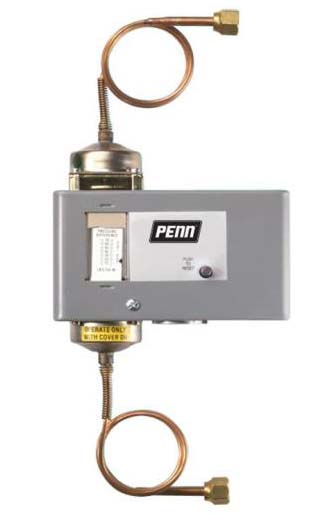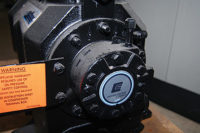Many larger refrigeration and air conditioning compressors — usually over 5 horsepower — have forced oiling systems. These compressors contain an oil pump located at the end of the compressor’s crankshaft (see Figure 1, top). The crankshaft is actually connected to the oil pump and supplies power, which turns the oil pump. The oil pump is keyed into the compressor’s crankshaft.
Oil pumps force oil through drilled holes or oil galleys in the crankshaft and deliver it to bearings and connecting rods. The oil then drops to the crankcase to be filtered and picked up again by the oil pump. Smaller compressors usually have some sort of splash-type oiling system. These systems may have an oil scoop that scoops and flings the oil throughout the crankcase, causing an oil fog as the crankshaft rotates.
Net Oil Pressure
Oil pumps can be of the gear or eccentric type. Gear-type oil pumps usually have a star gear that actually squeezes the oil to a higher pressure. The added pressure that the star gear puts into the oil can be referred to as the net oil pressure. Remember that the oil pump picks up the oil from the compressor’s crankcase (under crankcase pressure), adds pressure to the oil, and then delivers the oil into drilled holes or galleys in the crankshaft to be delivered to bearings and connecting rods.
Eccentric-type oil pumps use an eccentric type of mechanism to also squeeze the oil to a smaller and smaller volume, which adds pressure to the oil. Again, this squeezing action by the eccentric adds pressure to the oil, and this added pressure is referred to as net oil pressure.
When dealing with compressors that employ an oil pump, many service technicians confuse net oil pressure with oil pump discharge pressure. It is of the utmost importance that service technicians understand the difference between these two pressures when servicing compressors with oil pumps.
As mentioned earlier, the oil pump’s rotating gear or eccentric adds a certain pressure to the oil pumped through the crankshaft. This pressure is considered net oil pressure. Net oil pressure is not the pressure that can be measured at the discharge of the oil pump. The oil pump picks up oil (at crankcase pressure) from the compressor’s crankcase through a screen or filter. The oil pump discharge port’s pressure includes both crankcase pressure and oil pump gear pressure it adds to the oil. This is why net oil pressure cannot be measured directly with a gauge. A gauge at the oil pump’s discharge port would register a combination of crankcase pressure and oil pump gear pressure. The technician must realize this and subtract the crankcase pressure from the oil pump discharge port’s pressure to get the net oil pressure, as shown in the below equation:
(Oil pump discharge pressure) - (Crankcase pressure) = (Net oil pressure)
Net oil pressure is simply the pressure put behind the oil from the oil pump’s star gear or eccentric. For example, if the oil pump discharge pressure is 65 psig and the crankcase pressure is 15 psig, what would be the net oil pressure? The solution is to simply subtract the crankcase pressure from the oil pump discharge pressure to get net oil pressure:
(65 psi) - (15 psi) = 50 psi net oil pressure
This means the oil pump’s star gear or eccentric is actually putting 50 psi of pressure into the oil when delivering it into the crankshaft’s drilled passages. This is why oil safety controllers are called differential-type controllers: They sense the difference between oil pump discharge pressure and crankcase pressure. These controllers have a capillary tube or pressure transducer connected to the discharge of the oil pump and the crankcase in order to sense the difference of pressures or net oil pressure (see Figure 2, below).

FIGURE 2 - PRESSURE DIFFERENCE: Oil safety controllers have a capillary tube or pressure transducer connected to the discharge of the oil pump and the crankcase in order to sense net oil pressure. (Image courtesy of Ferris State University)
Net oil pressures usually range from 20 to 40 psi and vary from compressor to compressor. Most oil pressure safety controllers will shut down the compressor if the net oil pressure falls below 10 psi. Variables that affect the net oil pressure include:
- Bearing clearance;
- Viscosity of the oil;
- Temperature of the oil; and
- Compressor size.
Larger compressors need more net oil pressure, because they have more surface areas to lubricate. The oil pumps must also pump and carry the oil greater distances within the larger compressor. Also, as the oil gets hotter and its viscosity drops, the net oil pressure will also usually drop. As a compressor wears, its tolerances will become greater and easier for the oil to escape through its clearances.
Oil Safety Controller
The oil safety controller has a 2-minute time delay, which helps prevent nuisance trips. There are often times when the crankcase may have liquid refrigerant in it from an imperfect system. The 2-minute delay gives the crankcase time to clear any unwanted refrigerant during periods when refrigerant migration and/or flooding has occurred. It also avoids shutdowns during short fluctuations in net oil pressure on startups. Some of the causes why an oil safety controller may shut down a compressor include the following:
- Wrong oil in the compressor;
- Worn bearings or connecting rods;
- Excessively hot oil (low viscosity);
- Oil pump malfunction;
- Low oil level in crankcase;
- Old compressor (3-phase reversal);
- Broken oil line or blown gasket;
- Clogged oil screen or strainer; and
- Oil pressure safety controller malfunction.
Before servicing any refrigeration or air conditioning systems that contain an oil pump, technicians should make sure they understand the difference between net oil pressure and oil pump discharge pressure.








